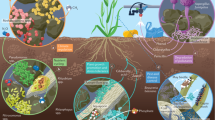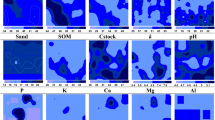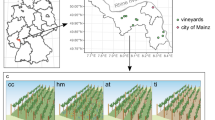Abstract
Relationships between soil microbial diversity and soil function are the subject of much debate. Process-level analyses have shown that microbial function varies with soil type and responds to soil management. However, such measurements cannot determine the role of community structure and diversity in soil function. The goal of this study was to investigate the role of gene frequency and diversity, measured by microarray analysis, on soil processes. The study was conducted in an agro-ecosystem characterized by contrasting management practices and soil types. Eight pairs of adjacent commercial organic and conventional strawberry fields were matched for soil type, strawberry variety, and all other environmental conditions. Soil physical, chemical and biological analyses were conducted including functional gene microarrays (FGA). Soil physical and chemical characteristics were primarily determined by soil textural type (coarse vs fine-textured), but biological and FGA measures were more influenced by management (organic vs conventional). Organically managed soils consistently showed greater functional activity as well as FGA signal intensity (SI) and diversity. Overall FGA SI and diversity were correlated to total soil microbial biomass. Functional gene group SI and/or diversity were correlated to related soil chemical and biological measures such as microbial biomass, cellulose, dehydrogenase, ammonium and sulfur. Management was the dominant determinant of soil biology as measured by microbial gene frequency and diversity, which paralleled measured microbial processes.
Similar content being viewed by others
Log in or create a free account to read this content
Gain free access to this article, as well as selected content from this journal and more on nature.com
or
References
Alef K, Nannipieri P . (1995a). Cellulase activity. In: Alef K., Nannipieri P. (eds.). Methods of Applied Microbiology and Biochemistry. Academic Press Inc: San Diego, CA, pp 346–347.
Alef K, Nannipieri P . (1995b). Estimation of nitrogenase activity of free-living bacteria in soils. In: Alef K., Nannipieri P. (eds.). Methods of Applied Microbiology and Biochemistry. Academic Press Inc: San Diego, CA, pp 243–245.
Anderson JPE, Domsch KH . (1978). A physiological method for the quantitative measurement of microbial biomass in soil. Soil Biol Biochem 10: 215–221.
Bodrossy L, Stralis-Pavese N, Murrell JC, Radajewski S, Weilharter A, Sessitsch A . (2003). Development and validation of a diagnostic microbial microarray for methanotrophs. Environ Microbiol 5: 566–582.
Bossio DA, Scow KM, Gunapala N, Graham KJ . (1998). Determinants of soil microbial communities: effects of agricultural management, season, and soil type on phospholipid fatty acid profiles. Microb Ecol 36: 1–12.
California Strawberry Commission (2009) California Strawberry Commission Website. Available: www.calstrawberry.com/. Accessed on 27 Nov 2009.
Dickens HE, Anderson JM . (1999). Manipulation of soil microbial community structure in bog and forest soils using chloroform fumigation. Soil Biol Bioch 31: 2049–2058.
Dungan RS, Ibekwe AM, Yates SR . (2003). Effect of propargyl bromide and 1,3-dichloropropene on microbial communities in an organically amended soil. FEMS Microb Ecol 43: 75–87.
Engelen B, Meinken K, von Wintzingerode F, Heuer H, Malkomes H-P, Backhaus H . (1998). Monitoring impact of a pesticide treatment on bacterial soil communitites by metabolic and genetic fingerprinting in addition to conventional testing procedures. Appl Environ Microbiol 64: 2814–2821.
Fitter AH, Gilligan CA, Hollingworth K, Kleczkowski A, Twyman RM, Pitchford JW . (2005). Biodiversity and ecosystem function in soil. Funct Ecol 19: 369–377.
Franzluebbers AJ, Haney RL, Hons FM, Zuberer DA . (1996). Active fraction of organic matter in soils with different texture. Soil Biol Biochem 28: 1367–1372.
Gao H, Yang ZK, Gentry TJ, Wu L, Schadt CW, Zhou J . (2007). Microarray-based analysis of microbial community RNAs by whole-community RNA amplification. Appl Environ Microbiol 73: 563–571.
Gentry TJ, Wickham GS, Schadt CW, He Z, Zhou J . (2006). Microarray applications in microbial ecology research. Microb Ecol 52: 159–175.
Girvan MS, Bullimore J, Pretty JN, Osborn AM, Ball AS . (2003). Soil type is the primary determinant of the composition of the total and active bacterial communities in arable soils. Appl Environ Microbiol 69: 1800–1809.
Griffiths BS, Ritz K, Bardgett RD, Cook R, Christensen S, Ekelund F et al. (2000). Ecosystem response of pasture communities to fumigation-induced microbial diversity reductions: an examination of the biodiversity– ecosystem function relationship. OIKOS 90: 279–294.
Griffiths BS, Ritz K, Wheatley R, Kuan HL, Boag B, Christensen S et al. (2001). An examination of the biodiversity—ecosystem function relationship in arable soil microbial communities. Soil Biol Bioch 33: 1713–1722.
Hassink J . (1994). Effect of soil texture on the size of the microbial biomass and on the amount of C and N mineralized per unit of microbial biomass in Dutch grassland soils. Soil Biol Biochem 26: 1573–1581.
He Z, Gentry TJ, Schadt CW, Wu L, Liebich J, Chong SC et al. (2007). GeoChip: a comprehensive microarray for investigating biogeochemical, ecological and environmental processes. ISME J 1: 67–77.
Ibekwe AM . (2004). Effects of fumigants on non-target organisms in soils. Adv Agron 83: 1–35.
Ibekwe AM, Papiernik SK, Gan J, Yates SR, Yang C-H, Crawley DE . (2001). Impact of fumigants on soil microbial communities. Appl Environ Microbiol 67: 3245–3257.
Kaiser EA, Mueller T, Joergensen RG, Insam H, Heinemeyer O . (1992). Evaluation of methods to estimate the soil microbial biomass and the relationship with soil texture and organic matter. Soil Biol Biochem 24: 675–683.
Kelly JJ . (2003). Molecular techniques for the analysis of soil microbial processes: functional gene analysis and the utility of DNA microarrays. Soil Sci 168: 597–605.
Klose S, Ajwa HA . (2004). Enzyme activities in agricultural soils fumigated with methyl bromide alternatives. Soil Biol Biochem 36: 1625–1635.
Koizumi Y, Kelly JJ, Nakagawa T, Urakawa H, El-Fantroussi S, Al-Muzaini S et al. (2002). Parallel characterization of anaerobic toluene and ethylbenzene degrading microbial consortia by PCR-denaturing gradient gel electrophoresis, RNA-DNA membrane hybridization and DNA microarray technology. Appl Environ Microbiol 68: 3215–3225.
Liebich J, Schadt CW, Chong SC, He Z, Rhee SK, Zhou J . (2006). Improvement of oligonucleotide probe design criteria for functional gene microarrays in environmental applications. Appl Environ Microbiol 72: 1688–1691.
Little AEF, Robinson CJ, Peterson SB, Raffa KE, Handelsman J . (2008). Rules of engagement: interspecies interaction that regulate microbial communities. Annu Rev Microbiol 62: 375–401.
Loy A, Lehner A, Lee N, Adamczyk J, Meier H, Schleifer K-H et al. (2002). Oligonucleotide microarray for 16s rRNA gene based detection of all recognized lineages of sulfate-reducing prokaryotes in the environment. Appl Environ Microbiol 68: 5064–5081.
Macalady JM, Fuller ME, Scow KM . (1998). Effects of metam sodium fumigation on soil microbial activity and community structure. J Environ Soil Qual 27: 54–63.
Mäder P, Fleissbach A, Dubois D, Gunst L, Fried P, Niggli U . (2002). Soil fertility and biodiversity in organic farming. Science 296: 1694–1697.
Malcomes HP . (1995). Ecotoxicology of soil fumigation. Effects of methyl bromide on microbial activities in soil under field conditions. J Plant Dis Prot 102: 606–617.
Reganold JP, Palmer AS, Lockhart JC, Macgregor AN . (1993). Soil quality and financial performance of biodynamic and conventional farms in New Zealand. Science 260: 344–349.
Rhee S-K, Liu X, Wu L, Chong SC, Wan X, Zhou J . (2004). Detection of genes involved in biodegradation and biotransformation in microbial communities by using 50-mer oligonucleotide microarrays. Appl Environ Microbiol 70: 4303–4317.
Rössner H . (1995). Chitinase activity. In: Alef K, Nannipieri P (eds.). Methods in Applied Soil Microbiology and Biochemistry. Academic Press: San Diego, CA, pp 360–361.
Schmidt EL, Belser LW . (1994). Autotrophic nitrifying bacteria. In: Weaver RW et al. (eds.). Methods of Soil Analysis Part 2—Microbiological and Biochemical Properties. Soil Sci. Soc. of Am: Madison, WI, pp 171–172.
Sigler WV, Turco RF . (2002). The impact of chlorothalonil application on soil bacterila and fungal populations as assessed by denaturing gradient gel electrophoresis. Appl Soil Ecol 21: 107–118.
Smith JL . (2002). Soil quality: the role of microorganisms. In: Bitton G. (ed.). Encyclopedia of Environmental Microbiology. John Wiley & Sons: New York, NY, pp 2944–2957.
Stralis-Pavese N, Sessitsch A, Weilharter A, Reichenauer T, Riesing J, Csontos J et al. (2004). Optimization of diagnostic microarray for application in analyzing landfill methanotroph communities under different plant covers. Environ Microbiol 6: 347–363.
Stromberger ME, Klose S, Ajwa H, Trout T, Fennimore S . (2005). Microbial populations and enzyme activities in soils fumigated with methyl bromide alternatives. Soil Sci Soc Am J 69: 1987–1999.
Tabatabai MA . (1994). Soil enzymes. In: RW Weaver et al. (eds.) Methods of Soil Analysis. Part 2, Microbiological and Biochemical Properties. Soil Sci Soc of Am: Madison, WI, pp 775–833.
Tiedje JM . (1994). Denitrifiers. In: R.W. Weaver et al (eds.). Methods of Soil Analysis Part 2, Microbiological and Biochemical Properties. Soil Sci Soc Am: Madison, WI, pp 256–257.
Torsvik V, Goksoyr J, Daale FL . (1990). High diversity in DNA of soil bacteria. Appl Environ Microbiol 56: 782–787.
Weil RR, Islam KR, Stine MA, Gruver JB, Samson-Liebig SE . (2003). Estimating active carbon for soil quality assessment: a simplified method for laboratory and field use. Am J Alternative Agric 18: 3–17.
Wu L, Kellogg L, Devol AH, Palumbo AV, Tiedje JM, Zhou J . (2008). Microarray-Based characterization of microbial community functional structure and heterogeneity in marine sediments from the gulf of Mexico. Appl Environ Microbio 74: 4516–4529.
Wu L, Liu X, Schadt CW, Zhou J . (2006). Microarray-based analysis of subnanogram quantities of microbial community DNAs by using whole-community genome amplification. Appl Environ Microbiol 72: 4931–4941.
Xiao CL, Duniway JM . (1998). Bacterial population response to soil fumigation and their effects on strawberry growth. Phytopathology 88 (suppl.): S100.
Yergeau E, Kang S, He Z, Zhou J, Kowalchuk GA . (2007). Functional microarray analysis of nitrogen and carbon cycling genes across an Antarctic latitudinal transect. The ISME J, 1–17.
Zelles L, Palojarvi A, Kandeler E, von Lutzow M, Winter K, Bai QY . (1997). Changes in soil microbial properties and phospholipid fatty acid fractions after chloroform fumigation. Soil Biol Biochem 29: 1325–1336.
Zhou J, Kang S, Schadt CW, Garten Jr CT . (2008). Spatial scaling of functional gene diversity across various microbial taxa. Proc Nat Acad Sci 105: 7768–7773.
Acknowledgements
This work was funded by The Organic Center (http://www.organic-center.org). Microarray analysis and the participation of Dr's Schadt and Zhou was supported by The United States Department of Energy under the Environmental Remediation Science Program, and Genomics: GTL program through the Virtual Institute of Microbial Stress and Survival (VIMSS; http://vimss.lbl.gov), Office of Biological and Environmental Research, Office of Science, and by the United States Department of Agriculture through NSF-USDA Microbial Observatories Program. We thank Tom Sjulin of Driscoll's Strawberry Associates and Larry Eddings of Pacific Gold Farms for assistance with farm selection. A special thanks to Drs Jan Dasgupta and Stuart Higgins for help and advice on statistical analysis. Additional thanks to Debbi Bikfasy, Margaret Davies, Mary Fauci and Emily Hollister for training and advice in lab protocols.
Author information
Authors and Affiliations
Corresponding author
Additional information
Supplementary Information accompanies the paper on The ISME Journal website
Supplementary information
Rights and permissions
About this article
Cite this article
Reeve, J., Schadt, C., Carpenter-Boggs, L. et al. Effects of soil type and farm management on soil ecological functional genes and microbial activities. ISME J 4, 1099–1107 (2010). https://doi.org/10.1038/ismej.2010.42
Received:
Revised:
Accepted:
Published:
Issue date:
DOI: https://doi.org/10.1038/ismej.2010.42
Keywords
This article is cited by
-
Soil meso- and micro-fauna community in response to bamboo-fungus agroforestry management
Scientific Reports (2022)
-
Diversity of endophytic bacterial microbiota in grapevine shoot xylems varies depending on wine grape-growing region, cultivar, and shoot growth stage
Scientific Reports (2022)
-
Co–elevation of CO2 and temperature enhances nitrogen mineralization in the rhizosphere of rice
Biology and Fertility of Soils (2022)
-
Soil microbiome manipulation triggers direct and possible indirect suppression against Ralstonia solanacearum and Fusarium oxysporum
npj Biofilms and Microbiomes (2021)
-
Impact of farming systems on soil ecological quality: a meta-analysis
Environmental Chemistry Letters (2021)



